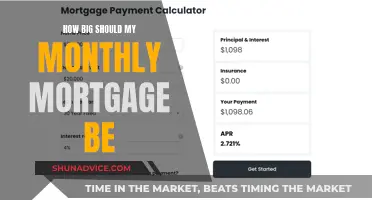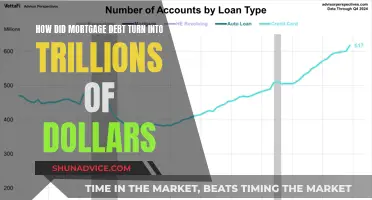
Adjustable-rate mortgages (ARMs) are a popular choice for homebuyers, especially those who plan to sell their homes or pay off their loans within a few years. ARMs have a variable interest rate that is initially fixed for a period of time, typically between three and ten years, and then fluctuates at regular intervals, usually every six or twelve months, for the remainder of the loan term. The popularity of ARMs increases when their introductory rates are lower than those of fixed-rate mortgages, as they offer smaller monthly payments and more homebuying power for borrowers. However, the potential for the rate and monthly payments to rise later on could make them unaffordable.
| Characteristics | Values |
|---|---|
| Definition | A home loan with a variable interest rate that’s tied to a specific benchmark |
| Interest Rate | Variable |
| Initial Interest Rate | Fixed for a period of time |
| Interest Rate Reset | Periodical, at yearly or monthly intervals |
| Interest Rate Reset Based On | A benchmark or index, plus an additional spread called an ARM margin |
| Interest Rate Reset Period | 3,5,7 or 10 years |
| Interest Rate Reset Frequency | Every six or 12 months |
| Common Interest Rate Reset Periods | 5/1, 5/6, 7/1, 7/6, 10/1 and 10/6 |
| Pros | Lower introductory rate and monthly payments, suitable for borrowers who plan to sell the home or pay off the loan within a few years |
| Cons | Harder to qualify for, monthly payments are guaranteed to go up if you opt for an interest-only ARM |
What You'll Learn

Adjustable-rate mortgages (ARMs) are a popular choice
The popularity of ARMs increases when their introductory interest rates are lower than those of fixed-rate mortgages, as this results in smaller monthly payments, giving borrowers more buying power. However, borrowers need to be cautious as the rate and monthly payments on an ARM have the potential to rise, which could make payments difficult to afford. Therefore, ARMs are best suited for borrowers who plan to sell the home or pay off the loan within a few years, taking advantage of the lower initial rates.
ARMs can be beneficial for those who know they will sell their home within five to ten years, as they can utilise the lower rates and payments and sell before the rate adjusts. Similarly, those starting their careers can benefit from the initial savings of an ARM, as their rising income should ideally offset any payment increases. Additionally, if borrowers expect rates to drop before their ARM rate resets, they can refinance to a lower rate and save a considerable sum.
While ARMs have their advantages, it is important to consider the potential drawbacks. ARMs can be more complicated to prepay, as adding extra to your monthly payment will not significantly shorten your loan term. Furthermore, it can be more challenging to qualify for an ARM compared to a fixed-rate mortgage, as they typically require a higher down payment and have stricter requirements for credit score, income, and DTI ratio.
Unlocking Government Mortgage Support: Claiming Your Money Back
You may want to see also

ARMs have a variable interest rate
An adjustable-rate mortgage (ARM) is a home loan with a variable interest rate that is tied to a specific benchmark or index. This means that the interest rate on an ARM can go up or down over time, depending on the performance of the benchmark or index it is linked to.
The variable interest rate of an ARM is typically fixed for an initial period, which can range from two to ten years, and is usually lower than the rate of a comparable fixed-rate mortgage. After this introductory period, the interest rate adjusts periodically, at yearly or monthly intervals, for the remainder of the loan term. These adjustments are based on a benchmark or index, such as the prime rate, the London Interbank Offered Rate (LIBOR), or the Secured Overnight Financing Rate (SOFR), plus an additional spread called the ARM margin.
The variable interest rate of an ARM can be advantageous in certain situations. For example, if you plan to sell your home or refinance your mortgage within a few years, an ARM can allow you to take advantage of the lower initial interest rate and save money on interest payments. Similarly, if you expect interest rates to drop before your ARM rate resets, refinancing to a lower rate at the right time could result in significant savings.
However, the variable interest rate of an ARM also comes with risks. Since the interest rate can fluctuate, it can be more challenging to budget for and may result in higher monthly payments over time. Additionally, the complexity of ARM interest rate calculations can make it more complicated to prepay the loan by adding extra to your monthly payments.
Overall, the variable interest rate of an ARM can be a beneficial option for borrowers who understand the risks and are comfortable with the potential for changing monthly payments.
My Mortgage Hardly Moved: What Gives?
You may want to see also

Pros and cons of ARMs
Adjustable-rate mortgages (ARMs) are a popular choice, especially for borrowers hoping mortgage rates will go down. They are also a good option for borrowers who want to save money during periods of rising interest rates. ARMs have a variable interest rate that is tied to a specific benchmark. The interest rate on an ARM is usually fixed for a period of time, after which it is reset periodically, at yearly or monthly intervals.
Pros
- ARMs often come with a lower initial interest rate than that of a comparable fixed-rate mortgage, resulting in lower monthly payments.
- If you plan to sell your home within a short period, you can take advantage of the lower rate and payments of an ARM and sell before the rate adjusts.
- If you plan to refinance, you can take out an ARM and then refinance to a lower rate at the right time to save money.
- If you are starting your career and know your income will increase over time, you can benefit from the initial savings of an ARM, with your rising income offsetting any payment increases.
- If rates decrease by the time your ARM resets, your monthly mortgage payments will shrink.
- There are limits to the amount by which an ARM can increase, with periodic and lifetime caps in place to restrict how much your rate can change.
Cons
- It can be more difficult to qualify for an ARM compared to a fixed-rate mortgage, as they usually require a higher down payment and factor in your credit score, income, and DTI ratio.
- Your monthly payments are guaranteed to go up if you opt for an interest-only ARM, where you pay only interest for a set time before also paying off the principal.
- Prepaying an ARM by adding extra to your monthly payment will not drastically shorten your loan term.
- If rates get so high that you hit the upper limit on your payments, you may not be paying off all the interest you owe for a given month, resulting in negative amortization, where your loan balance increases each month.
Gateway Mortgage: A Giant in the Industry
You may want to see also

How ARMs work
Adjustable-rate mortgages (ARMs) are home loans with a variable interest rate that's tied to a specific benchmark or index. The initial interest rate is fixed for a period, typically between three, five, seven, or ten years, and is usually lower than the rate of a fixed-rate mortgage. After the fixed-rate period, the interest rate on the outstanding balance resets periodically, at yearly or monthly intervals, and can fluctuate every six or twelve months for the remainder of the loan term. The London Interbank Offered Rate (LIBOR) was the typical index used for ARMs until October 2020 when it was replaced by the Secured Overnight Financing Rate (SOFR) to increase long-term liquidity.
ARM terms are typically listed as a fraction, with the top number representing the fixed introductory period and the lower figure indicating the frequency at which the rate will fluctuate afterward. For example, a 5/1 ARM has a set rate for five years and then resets every year, while a 5/6 ARM has a five-year fixed period and adjusts every six months. The most common ARM terms are 5/1, 5/6, 7/1, 7/6, 10/1, and 10/6.
During the introductory period, borrowers pay a lower monthly payment compared to a fixed-rate mortgage. However, once this period ends, the monthly payments can increase if interest rates rise, and there are limits on how fast and how high the rate can rise. Additionally, with an ARM, adding extra to the monthly payment may not significantly shorten the loan term, and prepaying a large lump sum may be more effective in reducing the term.
ARMs are best suited for borrowers who intend to sell the home or pay off the loan within a few years, as well as those who expect their income to increase over time, potentially offsetting any payment increases.
Borrowing Money for Mortgage Reinstatement: What You Need to Know
You may want to see also

ARMs vs. fixed-rate mortgages
Adjustable-rate mortgages (ARMs) are becoming an increasingly popular choice, especially for borrowers hoping mortgage rates will go down. They are typically 30-year loans with a variable interest rate that is tied to a specific benchmark and changes at set intervals after a fixed-rate introductory period.
ARMs tend to start with lower interest rates and lower monthly payments than comparable fixed-rate loans. The interest rate is fixed for a specified number of years, typically between three and ten years, and is usually lower than the rate you would get with a fixed-rate mortgage. After the fixed-rate period ends, the interest rate adjusts periodically, usually every six months or every year, based on an index like the London Interbank Offered Rate (LIBOR) or the Secured Overnight Financing Rate (SOFR).
The main advantage of an ARM is the potential for lower initial interest rates and monthly payments compared to fixed-rate mortgages. This can be beneficial for those planning to sell or refinance before the fixed-rate period ends or for those expecting a significant increase in income by then. Additionally, if market interest rates drop before the ARM rate resets, refinancing to a lower rate can save a considerable sum of money.
However, there are also downsides to ARMs. After the initial period, there is a chance that the interest rate will reset higher, increasing monthly mortgage payments. While ARMs have caps that limit how much the interest rate can change, it is still possible for the rate to increase substantially over time. Additionally, ARMs typically require a higher down payment of at least 5%, compared to 3% for some conventional fixed-rate loans.
On the other hand, fixed-rate mortgages offer predictability and certainty, as the interest rate remains the same throughout the life of the loan. This means that monthly payments of principal and interest will stay constant, providing stability for borrowers. Fixed-rate mortgages are the most common type of financing because they are the most predictable and there is no risk of increases in monthly principal and interest payments.
In conclusion, both ARMs and fixed-rate mortgages have their own advantages and disadvantages. ARMs may be a good option for those seeking lower initial interest rates and monthly payments, while fixed-rate mortgages provide stability and predictability over the long term. The best choice depends on an individual's financial circumstances and goals.
US Mortgage Debt: A Growing Concern for Americans
You may want to see also
Frequently asked questions
ARM stands for Adjustable-Rate Mortgage. It is a home loan with a variable interest rate that is initially fixed for a period of time, after which it is reset periodically.
ARM mortgages are a popular choice, especially for borrowers hoping that mortgage rates will go down. Most lenders offer ARMs.
ARM mortgages can be advantageous if you don't plan to stay in the home for a long time, if you plan to refinance, or if you are starting your career. They often come with a lower initial interest rate than fixed-rate mortgages, resulting in lower monthly payments.
ARM mortgages can be more complicated to prepay than fixed-rate mortgages. They can also be harder to qualify for, as they often require a higher down payment and factors like your credit score, income, and DTI ratio are considered. In addition, the monthly payments on an ARM mortgage can increase over time, making them potentially unaffordable.
The key factors to consider are your budget and long-term plans. If you have a limited budget and are looking for a lower initial interest rate, an ARM mortgage may be a good option. However, if you plan to own the home for a long time and prefer a consistent mortgage rate and monthly payment, a fixed-rate mortgage is probably a better choice.







